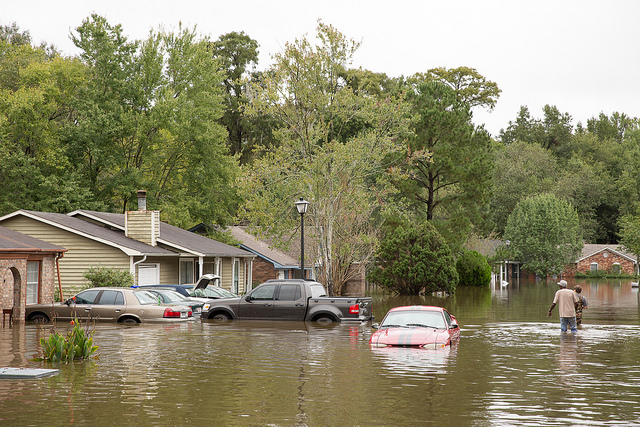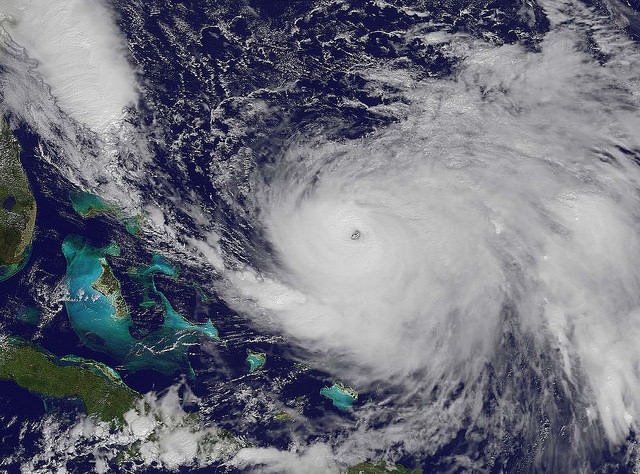By Megan Kriss
For Georgia students, October’s rain spurred by Hurricane Joaquin meant getting soaked while watching the Dawgs lose to rival Alabama. For Louisiana State University’s fans, it meant stepping back and letting an opposing team treat Baton Rouge like home. But for the almost 5 million residents of South Carolina, Hurricane Joaquin was, and is, much more personal. While the storm has moved on to threaten the Iberian Peninsula, South Carolina still fights to recover. At least 21 people have died. Hurricane Joaquin’s hardest hit, however, is its financial impact.
Flooding costs Americans more each year than any other type of natural disaster, with an average annual tab of $50 billion according to the Insurance Information Institute. The East Coast and Gulf Coast are particularly at risk due to the prevalence of hurricanes and other extreme tropical weather events on the western portion of the Atlantic Ocean. Of Time Magazine’s “Top 10 Historic U.S. Floods,” half occurred in the American Southeast. Unlike other disasters, most homeowner’s insurance policies do not cover flood damage, leaving the vast majority of victims to either pay out of pocket or take out hefty loans. Though South Carolina is home to almost five million, there are fewer than 200,000 flood insurance policies held in the state, though almost 75 percent of those are held in the effected counties. But of course, even flood insurance offers no consolation for the loss of irreplaceable items like photos, wedding dresses, and other mementos.
 Flooding in North Charleston
Flooding in North Charleston
Photo by Ryan Johnson
Aid, financial and otherwise, quickly mobilized after Hurricane Joaquin. Two disaster recovery centers sponsored by the South Carolina government were established around Columbia to provide money for home repairs and rent for temporary housing. Specialists in emergency management from both the state and federal governments are available at both centers to help survivors learn their options and apply for aid. Residents of 19 South Carolina counties qualify for individual assistance from the Federal Emergency Management Agency, but FEMA already has its hands full. The agency still has not entirely recovered from the controversies surrounding its handling of Hurricane Katrina and Superstorm Sandy. In March the agency promised to reopen and review all of the approximately 144,000 claims made against them by Sandy victims. This new disaster is surely no help to the already swamped agency trying to claw its way out of public disdain. Only time will tell if the agency succeeds in its initiative to better serve disaster victims.
Meanwhile, South Carolina’s congressional representatives are requesting more aid on top of FEMA assistance to help reverse the damage. One of these representatives, Republican Senator Lindsey Graham, has been the butt of controversy, drawing attention away from the aid needed in the state, because of he voted against providing hurricane relief to the Northeast in the wake of Hurricane Sandy. The senator says this apparent disparity is due to a difference in where funds come from. According to the senator, the funds that were requested for Sandy relief would require “additional, unappropriated funds,” while the funds he requested for his state’s relief would come from the already appropriated disaster relief fund, though he does warn that unrestrained relief funding for the natural disaster could “break the bank,” costing more than $1 billion.
Governor Nikki Haley, on the other hand, seems to have garnered more universal support and has acted as a leader for the state throughout the crisis. She even visited the coast where the most damage was inflicted. In an Oct. 11 press conference, she reassured those affected by flooding that “we will get through this.” The governor showed little patience for politicizing the damage caused by flooding, scolding one reporter who asked if damage done to infrastructure by Joaquin could have been prevented by greater funding in previous years. “I think the analysis of this can be done after,” she said.
While FEMA, Congressional members, and the Red Cross have done much to support survivors of the disaster, credit must also be given to Louisiana State University for its assistance to residents of South Carolina. The people of Louisiana have seen more than their fair share of hurricane related disasters, and they demonstrated empathy by moving the location of the LSU football game from the University of South Carolina to Louisiana. They further tried their best to make the “home” team still feel at home, hosting a tailgate for USC fans and ceremonially handing the keys to the stadium to USC’s student government. When it was announced that USC’s marching band was unable to attend the game, LSU’s band learned USC’s fight song and alma mater to play during the game.
We're welcoming @GamecockFB fans to BR this weekend on our digital billboards #StayStrong #Gamecocks #SCFloodRelief pic.twitter.com/ozvi3fOCp8
— Lamar Advertising (@LamarOOH) October 8, 2015
Even as the travesty of Hurricane Joaquin fades from the headlines, the residents of South Carolina strive to pick up their lives and move forward. Those interested in providing assistance to relief programs can provide financial or volunteer support to organizations such as Samaritan’s Purse, the American Red Cross, and the Salvation Army. Other organizations and opportunities can be found here and here. While the state has faced great hardship, sunny skies lie ahead both literally and figuratively, and as Governor Haley said, “We will get through this.”
